
Novo Resources (TSX:NVO) has issued an exploration update on its key projects in the Pilbara region of Western Australia. The update highlights significant developments at the Egina Gold Camp, Balla Balla Gold Project, and Nunyerry North, alongside recent advancements in joint venture activities.
Exploration Efforts at Egina Gold Camp and Balla Balla Gold Project
Novo Resources has been actively exploring the Mallina Basin and adjacent areas in the Pilbara since 2017, focusing primarily on gold but also investigating potential for lithium, base metals, and other commodities. This strategic exploration has led to notable successes, particularly with the discovery at Nunyerry North in 2023 and the formation of joint ventures with De Grey Mining (Egina JV) and Sociedad Quimica y Minera de Chile S.A. (SQM) under the Harding Battery Metals Joint Venture (HBMJV).
The Egina Gold Camp comprises a contiguous package of tenements situated within structurally complex, gold-fertile corridors of the Mallina Basin. This area, which includes the Nunyerry North prospect, has been a focal point of Novo’s exploration programs over the past 18 months, resulting in significant mineral discoveries.
Nunyerry North Drilling Results
In late 2023, Novo conducted a first-pass reverse circulation (RC) drilling program at Nunyerry North, focusing on a central zone of structurally controlled outcropping quartz veins. The program yielded high-grade gold intercepts, particularly in the Main Lode #1, situated within a brittle basalt unit between two shear zones. Noteworthy results include:
– 6 meters (m) at 6.12 grams per tonne (g/t) of gold (Au) from 37 m, including 5 m at 7.28 g/t Au from 37 m (NC017).
– 11 m at 2.52 g/t Au from 22 m, including 6 m at 4.19 g/t Au from 22 m (NC014).
– 13 m at 1.89 g/t Au from surface, including 4 m at 2.56 g/t Au from 3 m (NC004).
– 4 m at 5.71 g/t Au from 40 m, including 3 m at 7.47 g/t Au from 41 m (NC015).
– 17 m at 1.34 g/t Au from 37 m, including 4 m at 3.77 g/t Au from 50 m (NC022).
Following this, Novo completed a subsequent RC drilling program consisting of 34 holes for a total of 3,942 meters. The goal was to extend known mineralization in the Main Area and to test regional targets, including the Estrid Fault, Aurora West, and a porphyry unit south of the Skadi Shear. This latest program has successfully extended known mineralization by 250 meters to a total of approximately 500 meters in strike length, with notable results including:
– 9 m at 2.52 g/t Au from 87 m, including 2 m at 8.89 g/t Au from 92 m (NC061).
– 2 m at 7.38 g/t Au from 42 m (NC051).
– 11 m at 1.26 g/t Au from 85 m, including 4 m at 2.31 g/t Au from 85 m (NC053).
Results from the current program are being re-analyzed using the PhotonAssay™ method to better resolve any coarse gold component, with assays pending.
Targeted Drilling at Estrid Fault and Porphyry Targets
Three holes drilled into the Estrid Fault target, defined by high-order soil anomalies and surface alteration, produced significant gold intercepts, including:
– 13 m at 2.68 g/t Au from 66 m, including 3 m at 10.41 g/t Au from 66 m (NC046).
– 11 m at 2.20 g/t Au from 84 m, including 1 m at 18.06 g/t Au from 86 m (NC046).
– 2 m at 6.30 g/t Au from 15 m (NC062).
– 17 m at 1.85 g/t Au from 25 m, including 7 m at 3.55 g/t Au from 25 m (NC063).
Additionally, three holes drilled into the porphyry target intersected a porphyritic rhyolite to rhyodacite with pyrite mineralization. The best result was 7 m at 0.1 g/t Au, with elevated copper levels. Despite these findings, the results do not warrant immediate follow-up in the target area, though they indicate the potential for further exploration in the district.
Egina JV and Balla Balla Gold Project Developments
De Grey Mining is advancing the first stage of its earn-in at the Egina JV, where it must spend a minimum of A$7 million by December 2024 to secure its interest. As part of this, De Grey has initiated follow-up aircore (AC) and RC drilling programs at the Becher Project, with approximately 28,000 meters of drilling planned. To date, 38 RC holes and 201 AC holes have been completed, with results anticipated in late Q3 2024.
Meanwhile, Novo has made progress at the Balla Balla Gold Project, where a Determination Wide Aboriginal Heritage Protection Agreement has been signed with the Kariyarra Aboriginal Corporation. This agreement, which includes customary compensation for the Kariyarra People, enables the grant of tenement application E47/4703, prospective for gold, base metals, and lithium. A cultural site avoidance heritage survey has already been completed, paving the way for AC drilling to commence once the tenement is granted.
Mapping and Sampling at Tabba Tabba Shear Corridor
Novo is also advancing exploration at the Tabba Tabba Shear Corridor, a mantle-tapping structure in the Southern Egina Gold Camp. The company has recently completed a re-interpretation of the corridor, identifying several conceptual targets for future exploration. Novo has begun mapping and surface sampling over these targets, with plans to collect approximately 1,200 surface soil samples.
Novo Resources continues to advance its exploration efforts across the Pilbara region, with a focus on expanding known mineralization and uncovering new prospects. The company’s strategic partnerships and joint ventures with De Grey Mining and SQM provide financial backing and expertise, enabling Novo to pursue its exploration objectives with greater flexibility. As assays and survey results from ongoing programs become available, further updates are expected in the coming months.
The above references an opinion and is for information purposes only. It is not intended to be investment advice. Seek a licensed professional for investment advice. The author is not an insider or shareholder of any of the companies mentioned above.

De Grey Mining has recommenced exploration drilling at the Becher Project in Western Australia’s Pilbara region, following up on promising results from late 2023. The project is part of the Egina Joint Venture between De Grey and Novo Resources (TSX:NVO), covering a strategically significant land position in the gold-prospective Mallina Basin.
Novo Executive Co-Chairman and Acting CEO Mike Spreadborough commented in a press release: “This is an exciting time for the Egina JV with the recommencement of AC and RC drilling programs at our flagship Becher Project. De Grey are focused on undertaking a further 28,000m of combined drilling, which of course is a follow on from the initial program completed at the end of 2023 and will continue to advance key targets identified by Novo historically. Becher is a highly prospective and high priority exploration target. We eagerly await the results of the drilling programs and look forward to updating shareholders in due course.”
In the fourth quarter of 2023, De Grey completed over 10,500 meters of aircore (AC) and reverse circulation (RC) drilling at Becher, testing multiple targets including the Heckmair and Lowe intrusions, and the Irvine and Bonatti shear corridors. Significant results were returned from both the Lowe and Heckmair prospects, which have been designated as priority areas for follow-up work.
The new drilling campaign, which began in late May 2024, involves two rigs conducting a proposed 28,000-meter combined AC and RC program. De Grey plans to follow up on encouraging results at Lowe, Heckmair, and Whillans prospects.
At the Lowe prospect, located approximately 20 kilometers west-southwest of De Grey’s 12.7 million ounce Hemi Gold Project, previous RC drilling intersected 8 meters at 4.7 grams per tonne gold from 97 meters depth in one hole. The current program includes 220 AC holes totaling about 11,000 meters to test the western extension of the target stratigraphy, as well as six RC holes totaling approximately 500 meters.
The Heckmair prospect yielded notable base metal results in late 2023, including intersections of silver, copper, lead, and zinc, along with gold values. De Grey interprets these results as potentially indicative of a mineralized system within a 1.5-kilometer long fault zone. The ongoing RC program at Heckmair comprises 27 holes for about 3,000 meters, testing the fault over a 2-kilometer strike length.
Additionally, an extensive AC program of 532 holes for approximately 23,500 meters is underway across the project area. This work aims to expand geochemical coverage over untested mafic and ultramafic intrusions, including anomaly definition at Lowe and Heckmair, and preliminary testing of the Bonatti, Irvine, and Whillans prospects.
The Becher Project is part of the broader Egina Gold Camp, which Novo Resources describes as a highly prospective gold belt. The Egina Joint Venture, formed in June 2023, allows De Grey to earn a 50% interest in the project by spending A$25 million over four years, with a minimum commitment of A$7 million by December 2024.
Results from the current drilling programs are anticipated in the second half of 2024. However, it should be noted that while the area shows promising indicators, there is no assurance that a commercially viable mineral deposit will be determined at the Becher Project.
The Egina Joint Venture area, combined with De Grey’s existing holdings, covers approximately 2,500 square kilometers in the Mallina Basin. This region has gained significant attention following De Grey’s Hemi discovery, although the presence of similar mineralization at Becher remains to be proven.
Highlights from the results are as follows:
- Follow-up aircore (AC) and reverse circulation (RC) drilling programs have been commenced by De Grey Mining (De Grey) at Novo’s flagship Becher Project (Becher), using two drill rigs. The focus is on testing gold and base metal mineralisation at the priority Heckmair and Lowe Prospects.
- Becher is part of the Egina Joint Venture, where major ASX-listed Western Australian gold explorer and developer De Grey is earning-in through a minimum spend of A$7 million to December 2024, as part of a required A$25 million spend over 4 years to earn 50% of the joint venture. De Grey is the manager of the Egina Joint Venture.
- Becher lies adjacent to De Grey’s 12.7 Moz1 Hemi Gold Project.
- Exploration completed to date by Novo and De Grey at Becher has identified both intrusion-hosted and structurally controlled gold mineralisation similar in nature to that at the Hemi deposit.
- De Grey plans to undertake a further 28,000 m of combined AC and RC drilling, adding to the ~10,500 m already completed at Becher in Q4 2023.
- Separately, drilling by Novo at Nunyerry North, where a ~4,000 m RC drill program commenced in late May, is advancing with the program expected to be completed in early July and assay results received later in the month.
- Following completion of drilling at Nunyerry North, exploration at key Pilbara targets will shift to either AC drilling at the Balla Balla Gold Project or RC drilling in the Karratha District gold and gold-copper (+-platinum-palladium) targets, dependent on the timing of heritage surveys and final approvals, which are expected in late July 2024.
The above references an opinion and is for information purposes only. It is not intended to be investment advice. Seek a licensed professional for investment advice. The author is not an insider or shareholder of any of the companies mentioned above.
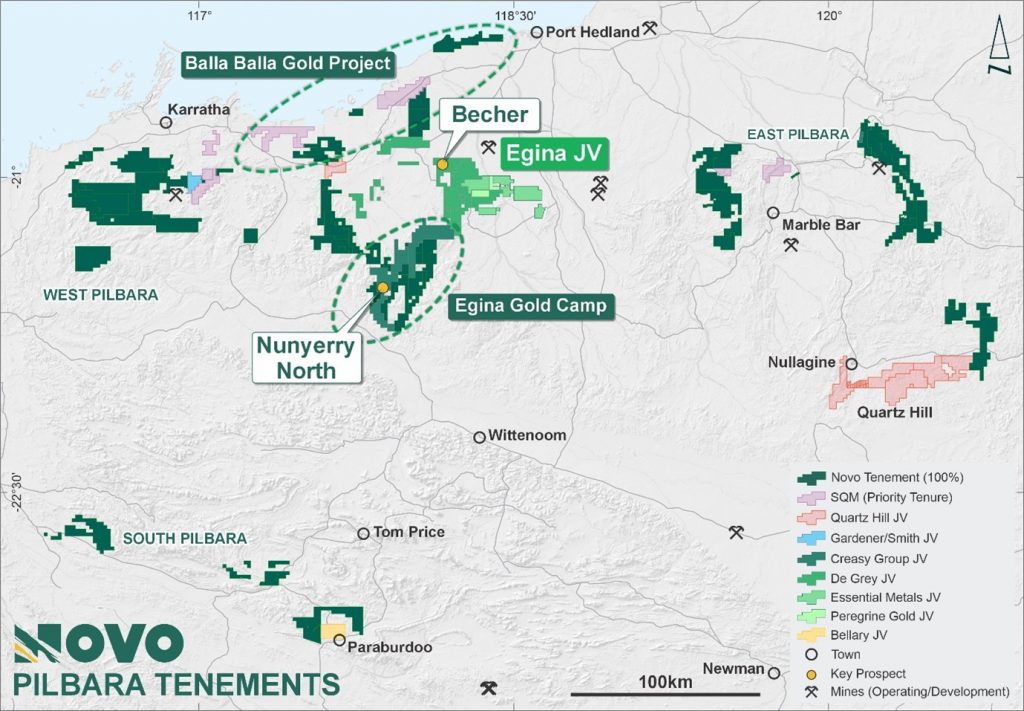
Novo Resources Corp. (ASX:NVO)(TSX: NVO) has provided an update on recent drilling by joint venture partner De Grey Mining (ASX:DEG) at the Becher Project, part of Novo’s highly prospective Egina gold belt in the Pilbara region of Western Australia.
The Becher Project is under an earn-in and joint venture agreement with De Grey, under which De Grey can earn a 50% interest in the project by spending up to A$25 million over four years on exploration.
Novo Executive Co-Chairman and Acting CEO Mike Spreadborough commented in a press release: “This set of results from the recent drilling is very exciting. De Grey has a total of 39,000 m of drilling planned under this program. This ground is going to get some focused exploration attention with De Grey required to spend up to A$25 million at Becher and adjacent tenements within 4 years, to earn a 50% direct interest in the Egina JV. In this programme, a minimum $7 million will be spent within 18 months, so we expect a good flow of results going forward. What excites us the most at Novo is that the Egina JV tenements are considered highly prospective for significant intrusion related gold deposits, with similar attributes to the 12.7 Moz Au (JORC 2012) Hemi Gold Project. De Grey understand the enormous potential of this ground, and this is just the start of an exciting exploration partnership.”
Since August 2023, De Grey has completed over 10,500 meters of aircore (AC) and reverse circulation (RC) drilling at the Becher Project, testing priority targets at the Heckmair and Lowe intrusions and the Irvine and Bonatti shear corridors.
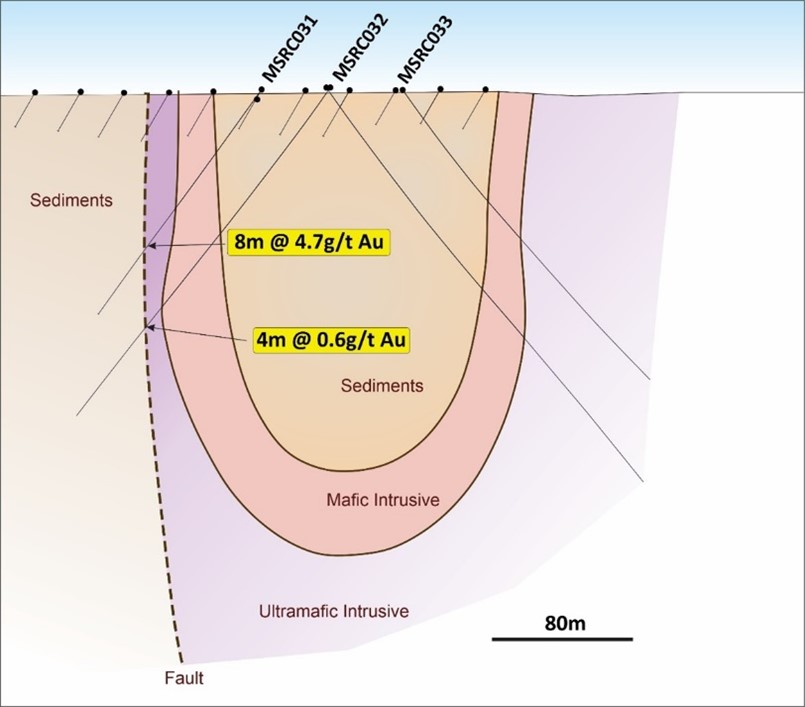
Results include an intersection of 8 meters at 4.7 g/t gold from 97 meters depth in hole MSRC0031 at the Lowe prospect. This drilling also intersected 4 meters at 0.6 g/t gold from 144 meters in hole MSRC0032. The mineralization is hosted in strongly foliated and sheared pyroxenite and gabbro.
At the Heckmair prospect, the best gold intercept was 2 meters at 2.8 g/t gold in hole MSRC0013, associated with a 1.5 km long northwest-trending fault zone.
De Grey notes that other deposits in the region demonstrate that base metal anomalism can indicate nearby gold mineralization. The company sees the Heckmair Fault as a priority target for further RC drilling in 2024.
Novo’s Egina gold belt comprises structurally complex, gold-mineralized corridors trending towards De Grey’s 12.7 million ounce Hemi gold project. Novo sees significant discovery potential across its 80 km strike length land package along this trend.
The positive drilling results at targets identified in early-stage reconnaissance work continue to highlight the prospectivity of Novo’s Pilbara gold projects. Further assay results are pending as exploration programs progress under the De Grey joint venture.
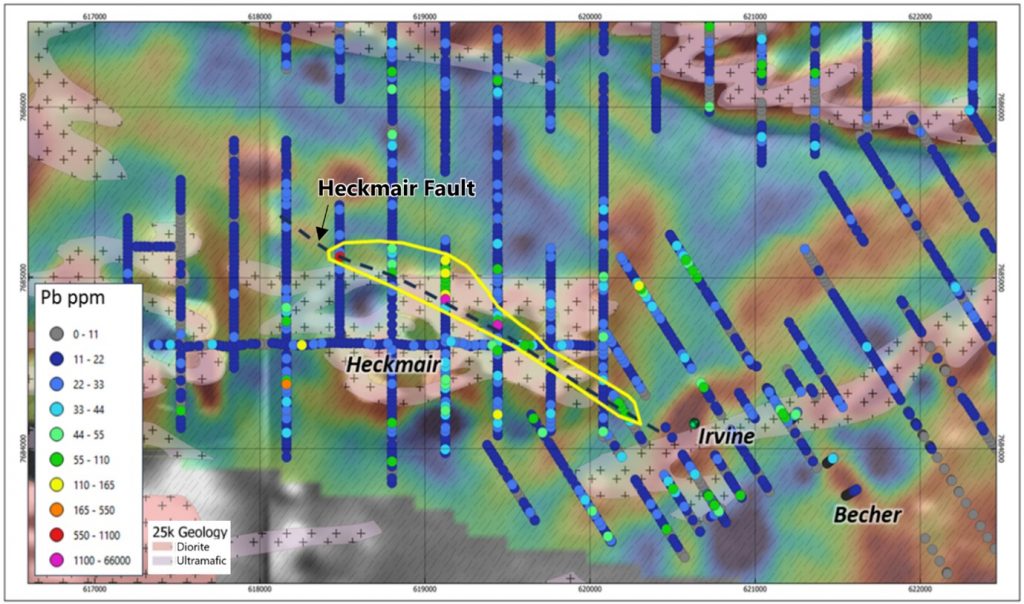
- More than 10,500 m of combined aircore (AC) and reverse circulation (RC) drilling completed by De Grey Mining (ASX: DEG) at the Becher Project in Q4 2023, as part of the Egina earn-in/JV
- RC drilling at Lowe confirmed gold mineralisation associated with a deformed intrusive sill, with a best intercept of 8 m at 4.74 g/t Au from 96 m, including 3 m @ 11.88 g/t Au from 100 m (MSRC0031)
- Follow-up RC drilling into a base metal-gold corridor previously defined by Novo at Heckmair, intersected a significant zone of base metal-gold mineralisation from the two RC holes targeting the corridor. Results include:
- 10 m @ 0.12 g/t Au, 29.7 g/t Ag, 0.3% Cu, 1.5% Pb and 1.8% Zn from 40 m (MSRC0016)
including 3 m @ 0.20 g/t Au, 59.8 g/t Ag, 0.9% Cu, 2.4% Pb and 2.2% Zn from 47 m - 24 m @ 0.2 g/t Au, 13.2 g/t Ag, 0.1% Cu, 1.0% Pb and 0.1% Zn in hole MSRC0017 from 105 m (MSRC0017)
including 6 m @ 0.48 g/t Au, 20.8 g/t Ag, 0.2% Cu, 1.4% Pb and 2.8% Zn from 105 m
- 10 m @ 0.12 g/t Au, 29.7 g/t Ag, 0.3% Cu, 1.5% Pb and 1.8% Zn from 40 m (MSRC0016)
- The base metal corridor trends WNW through the Heckmair intrusion, with broad intervals of anomalous base metals and low-level gold mineralisation mapping a fault to over 1.5 km in strike
- Resampling of anomalous gold zones from Novo’s 2023 AC program completed by De Grey, has verified broad zones of gold anomalism associated within granitic intrusions
- De Grey plans to target the Becher area with follow up AC and RC drilling to be completed at priority targets Heckmair and Lowe in 2024
The above references an opinion and is for information purposes only. It is not intended to be investment advice. Seek a licensed professional for investment advice. The author is not an insider or shareholder of any of the companies mentioned above.
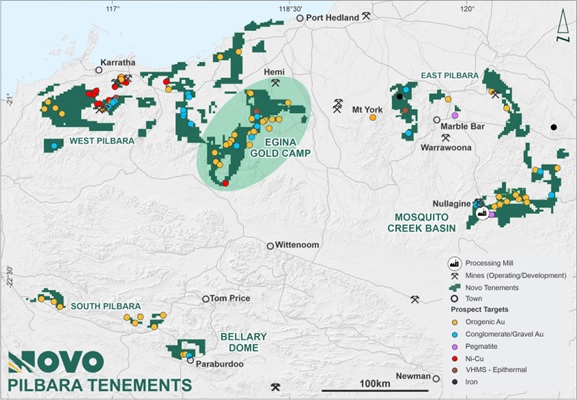
Novo Resources Corp. (TSX: NVO) has recently announced the launch of a comprehensive +20,000m aircore (AC) drilling program at the company’s flagship Becher Project, located in the northern sector of the Egina Gold Camp.
Novo Executive Co-Chairman and Acting CEO Mike Spreadborough commented on the drill program in a press release: “We are very excited to have recommenced drilling at our flagship Becher Project, as we embark on a targeted +20,000 m follow-up program for this quarter. Importantly, results from our 2022 drill program have confirmed the right geological indicators for discovery success and we believe there is significant prospectivity in the Becher area.”
The Becher Area (E47/3673), 100%-owned by Novo, boasts multiple high-priority orogenic gold targets under shallow cover in the highly prospective, yet under-explored, Mallina Basin. The project is situated approximately 28 km west-southwest of De Grey Mining Limited’s Hemi deposit and along an interpreted gold-fertile corridor, just 2.5 km south of their recent Withnell South discovery.
Novo’s 2022 drilling program has proven to be extremely successful on several fronts:
- Gold assay results from drill sampling provide confidence in the fertility of the interpreted regional structural corridors.
- Multi-element analysis of bottom-of-hole AC drill samples revealed intrusion-related “sanukitoid” signatures, known hosts to gold mineralization elsewhere in the district.
- The distribution of pathfinder elements such as arsenic, antimony, and tungsten helped finesse understanding of the controls on gold mineralization.
- The realization that the cover sequence is shallow (generally less than 10m) and less consequential than expected is particularly noteworthy.
These findings will significantly influence the targeting and prioritization of the 2023 drill programs.
Final results have been received for 1m split samples sourced from 4m composite samples in the reverse circulation (RC) and AC drilling completed in 2022. The new results closely mirror intercepts from previously reported composite samples and include high-grade assays as follows:
- 1m @ 7.27 g/t Au from 9m (F0632) at the intersection of the Irvine and Heckmair trends
- 1m @ 3.1 g/t Au from 17m (F519) at Whillans
- 1m @ 4.27 g/t Au from 17m (F1393) at Bonatti
New results also highlight potential for Intrusion Related Gold (IRG) mineralization at Irvine South, supported by highly anomalous Au-Cu results and associated pathfinder elements (Au-Ag-Cu-Bi-Mo-Sb) in AC on the most southerly line drilled in 2022. The presence of a strong magnetic target, coincident with the edge of current drill coverage and its location immediately west of the Becher epithermal vein system, provides further support for this possible target style.
The current AC program will test multiple high-priority structural and intrusion-hosted gold targets, similar to De Grey’s Mallina Gold Project. These targets have been defined by significant gold and pathfinder anomalies in an area of approximately 20 sq km, delineated in anomalous structural corridors at the Heckmair, Irvine, and Whillans prospects. Additional targets are also emerging from partly completed reconnaissance drilling at Lowe and Bonatti. A minimum of 20,000m of AC will be conducted as part of the program, which commenced in mid-April 2023 and will be completed in June 2023.
2022 Exploration Program Details
In mid-2022, Novo commenced a major exploration campaign to test multiple significant shear corridors adjacent to De Grey’s 10.6 Moz Au (JORC 2012) Mallina Gold Project. Numerous targets
were generated from detailed ground magnetic surveys, regional and local scale geochemical programs, and geological mapping. The 2022 exploration program comprised:
- 9,200m of AC drilling
- 1,000m of RC drilling
- 6,000m of diamond drilling
- Detailed mapping and rock chip sampling
The 2022 drilling campaign successfully identified multiple high-grade gold intercepts, broad mineralized zones, and a new Intrusion-Related Gold (IRG) target. The results from this exploration program have expanded Novo’s understanding of the mineralization and structural controls within the Becher Project area.
Irvine South Target
The 2022 program identified the Irvine South target, which shows potential for IRG mineralization. A highly anomalous Au-Cu signature was found in AC drilling on the southernmost line, supported by associated pathfinder elements (Au-Ag-Cu-Bi-Mo-Sb). The presence of a strong magnetic target along the edge of the current drill coverage and its proximity to the Becher epithermal vein system further supports this new target style.
2023 Exploration Program Details
The 2023 AC drilling program will test multiple high-priority gold targets that have been identified by significant gold and pathfinder anomalies within a 20 sq km area at the Heckmair, Irvine, and Whillans prospects. Additional targets are also emerging from partly completed reconnaissance drilling at Lowe and Bonatti. The program will include a minimum of 20,000m of AC drilling, which commenced in mid-April 2023 and will be completed by June 2023.
Upcoming Drilling Plans
The company’s near-term plans include additional follow-up AC drilling in areas of the project that have demonstrated significant potential. Diamond drilling will also be conducted to test high-grade mineralization at depth and to provide more precise information on the structural and lithological controls on gold mineralization.
The above references an opinion and is for information purposes only. It is not intended to be investment advice. Seek a licensed professional for investment advice. The author is not an insider or shareholder of any of the companies mentioned above.
Novo Resources Corp. (TSX:NVO) has begun a reverse circulation (RC) drill program focused on the Catia Prospect and the Edney’s Find Prospect at the Bellary Dome Project in South Pilbara, Western Australia. The company has identified Bellary as one of its priority target areas across its significant 10,500 sq km landholding in the Pilbara.
Mike Spreadborough, Novo’s Executive Co-Chairman and Acting Chief Executive Officer, commented in a press release: “The Bellary Dome Project is one of Novo’s priority areas across its significant 10,500 sq km landholding in the Pilbara. We are excited to get on the ground and start testing these highly prospective targets, that were identified during our previous field work program. We anticipate the programme will take four weeks, with results released as they are received. This is the first of several drilling programs Novo plans for its current season of exploration.”
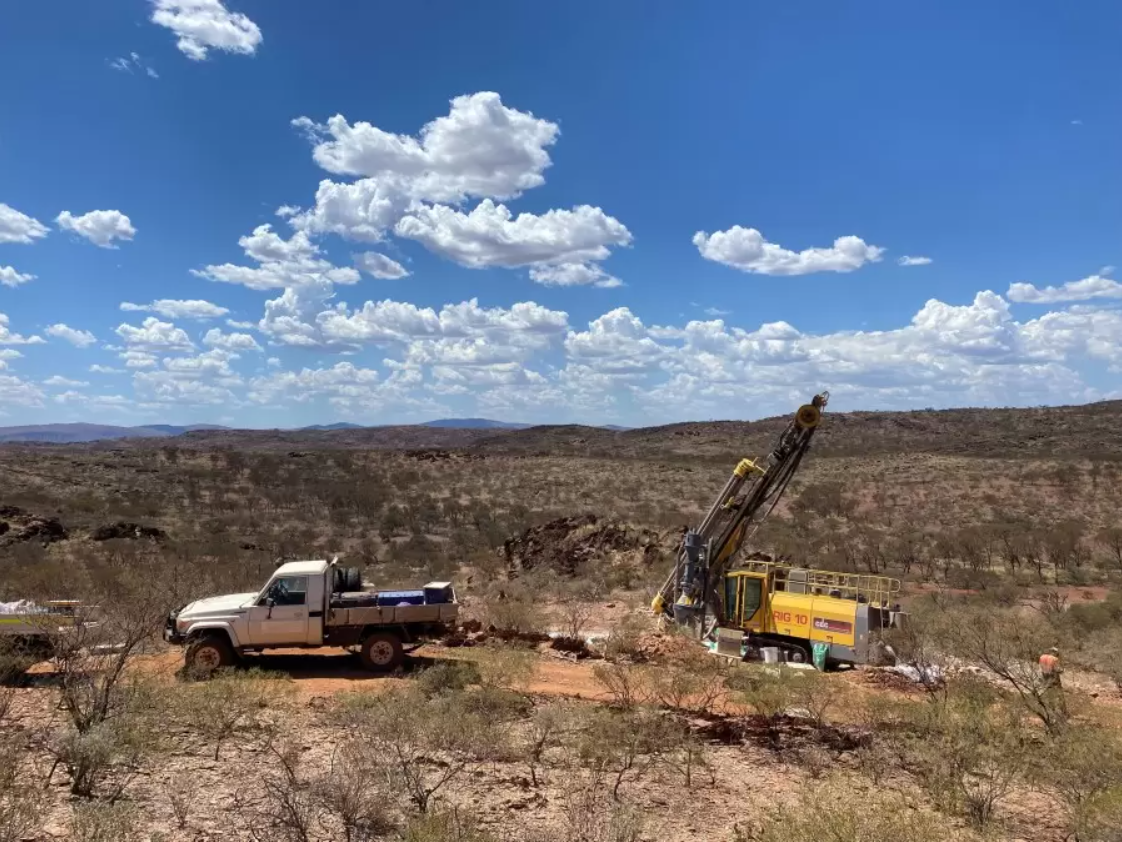
Novo entered into an option agreement with Bellary Dome Pty Ltd in June 2020 to acquire the gold-only rights on E47/3555, while Bellary Dome Pty Ltd retains the rights to all other minerals and ownership of the tenement under the agreement. The area of structural uplift along the southern margin of the Pilbara Craton has been identified by both historic and more recent explorers as having significant gold targets.
Fieldwork carried out by Novo and historical exploration reviews completed in 2020/2021 highlighted several gold targets, with Catia and Edney’s Find prioritised for drilling. Catia is a structurally complex area comprising sulphidic quartz veins hosted in highly foliated basalt and sedimentary rocks. It hosts a network of shallow and steep dipping gold-rich quartz veins within a regional west-northwest trending shear zone.
Rock chips from reconnaissance mapping and sampling by Novo returned significant anomalous gold values, with peak results of 556 ppm Au and 117 ppm Au. Additionally, broad-scale carbonate, silica, and sulphide alteration has been identified across all stratigraphic units at Bellary.
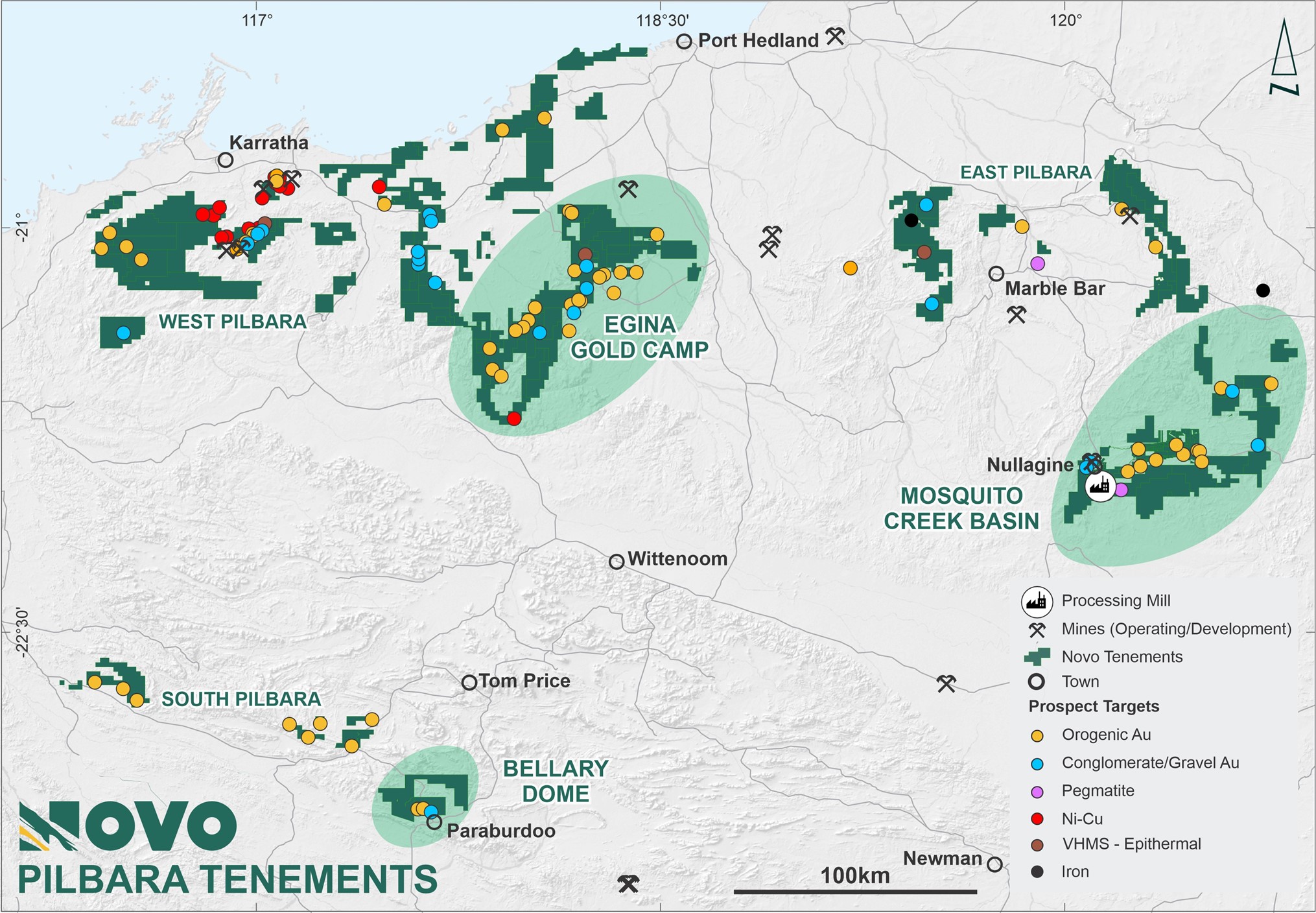
Soil sampling completed in 2021 by Novo highlighted a coherent bullseye Au-Ag-Pb-Sb anomaly in the immediate vicinity of the Catia vein system. It also identified a significant soil anomaly 700m further east-southeast from the prospect along what is interpreted as a continuation of the Catia Shear.


The commencement of the RC drill program is a positive development for Novo as it aims to further explore the gold potential of the Catia and Edney’s Find prospects at Bellary. Novo’s 10,500 sq km landholding in the Pilbara continues to be a priority target area for the company as it seeks to uncover new sources of gold.
Exploration for gold at Edney’s Find, a conglomerate-hosted gold occurrence located in Western Australia, is gaining momentum as Novo Resources, a Canadian exploration company, plans to drill several short holes to test the area’s gold endowment.
Edney’s Find has been explored by various companies since the 1970s and is known for its significant historical and recent prospector activity. The area boasts of dry-blowing spoils, historic pits, and a small shaft, all of which indicate the presence of gold.
The region is dominated by Bellary Formation sediments, which comprise arkosic sandstone, quartzite, shale, and conglomerate. The conglomerate is clast-supported and has clast sizes that vary from pebble to cobble size. Furthermore, zones of the conglomerate show disseminated buckshot pyrite, up to 10mm in diameter.
Novo’s efforts have been fruitful, with a peak gold value of 36.4 ppm Au recorded in a trench rock chip sample in 2020. As a result, the company plans to drill several short holes to further test the gold endowment of the conglomerate.
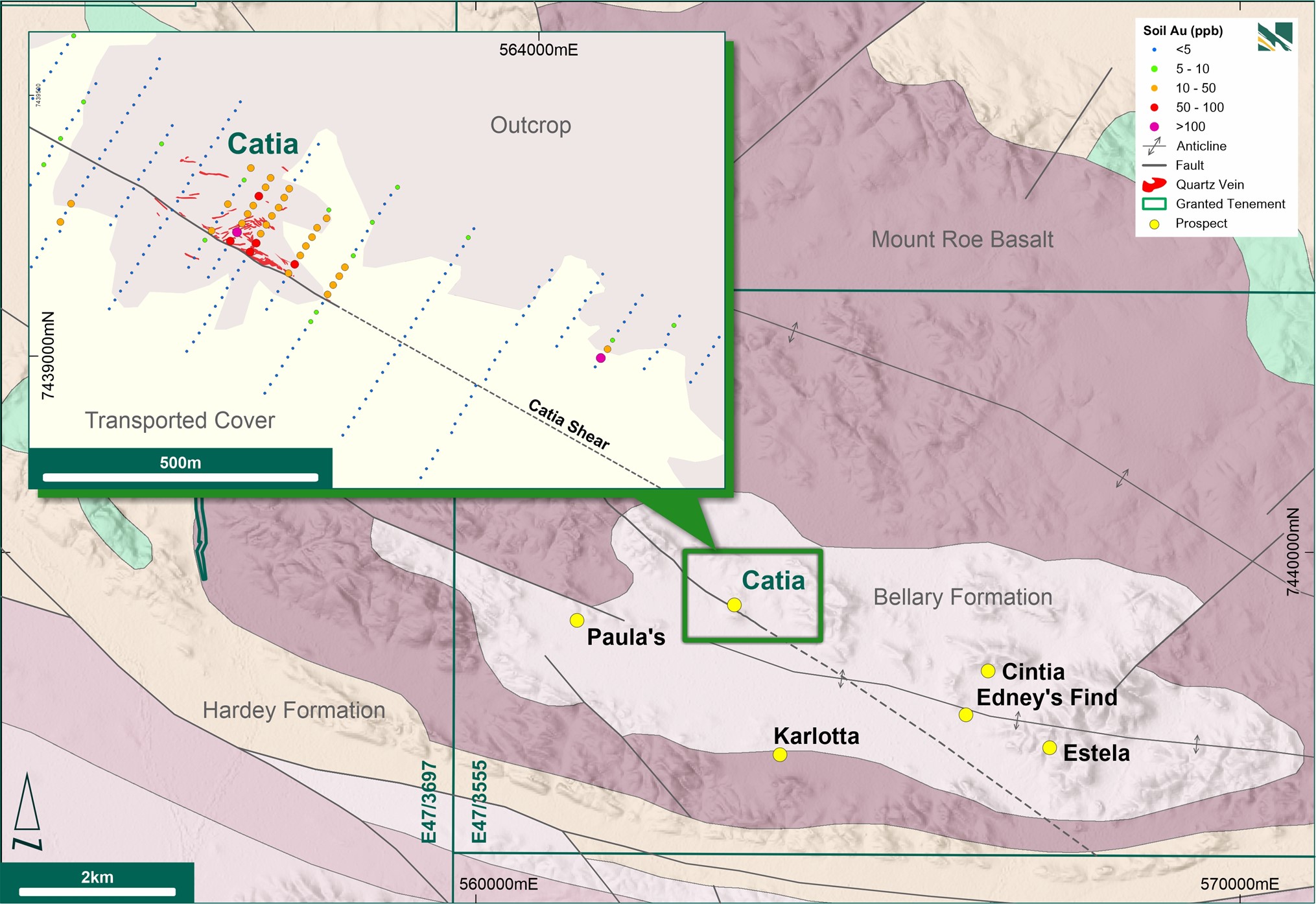
Exploration in the region has been ongoing for several decades, and previous work includes mapping, surface sampling, trenching, and drilling. The conglomerate’s unique characteristics, combined with the region’s history of gold mining, have piqued the interest of explorers.
Highlights from the announcement are as follows:
- The Bellary Dome Project is one of Novo’s priority areas across its significant 10,500 sq km landholding in the Pilbara region of Western Australia.
- A 3,000 m reverse circulation drill program has commenced at the Catia Prospect, part of the Bellary Dome Project.
- Highly prospective gold mineralisation at Catia is structurally controlled and quartz vein related.
- High-grade gold results returned from rock chip sampling in 2021 include peak results of 556 ppm gold and 117 ppm gold.
- Step-out drilling will test the strike potential of the Catia Trend for 700 m along strike, under cover to the east of the Catia Prospect main target.
Results referred to in this news release are not necessarily representative of mineralisation throughout the Bellary area.
The above references an opinion and is for information purposes only. It is not intended to be investment advice. Seek a licensed professional for investment advice. The author is not an insider or shareholder of any of the companies mentioned above.
Novo Resources (TSX:NVO) has provided an exploration update from its Malmsbury Project and the adjacent Queens Project, location roughly 50km south-southwest of the high-grade Fosterville mine in Victoria, Australia. Both projects are 50%-owned by Novo Resources. The Malmsbury Project is a joint venture with GBM Resources and the company has a joint venture with Kalamazoo Resources for the Queens Project.
Novo’s Executive Co-Chairman, acting Chief Executive Officer, and director Mike Spreadborough commented in a press release: “We are very pleased with the most recent set of assay results from drilling at the Malmsbury project, highlighted by strong grades generated at the Queens Birthday and Leven Star reefs, along with a compelling result from step-out hole MD22.
“We know this region is highly prospective and we will continue to systematically test compelling targets to build each project in size and scale. The team in Victoria are doing an excellent job and we are excited by the future growth potential of our Victorian project portfolio.”
Highlights from the exploration update are as follows:
- New exciting high-grade assay results received from the 11-hole, 3,162 m diamond drilling program recently completed at the 50%-owned Malmsbury gold project (“Malmsbury Project”) located 50 km SSW of the high-grade Fosterville gold mine in Victoria, Australia.
- Significant results generated from the last two holes drilled in the program at Queens Birthday (MD20) and Leven Star (MD21) reefs include:
- 3.1 m @ 9.27 g/t Au from 400.9 m (MD20);
- 8.1 m @ 5.79 g/t Au from 131.9 m (MD21); and
- 6.2 m @ 3.92 g/t Au from 144.6 m (MD21).
- Step-out hole MD22 returned 45 m @ 0.23 g/t Au from 134 m successfully intersecting the gold-mineralised felsic intrusive (Missing Link Monzogranite) 80 m north of previous reported drilling (MD171).
- These new results together with previously released results affirm the success of this drilling program and support the exploration potential of the Malmsbury Project.
- Induced polarization (“IP”) survey commenced on the Malmsbury Project and adjacent 50%-owned Queens gold project (“Queens Project”). Ground gravity and magnetic data to be collected concurrently with the IP survey. Novo expects this will take approximately six weeks to complete.
- Diamond drilling planned for H1 2023 will test remaining high-priority mapping targets at the Malmsbury Project, in addition to developing high-grade shoot potential on the Leven Star Reef and key significant results from the recent diamond drilling campaign.
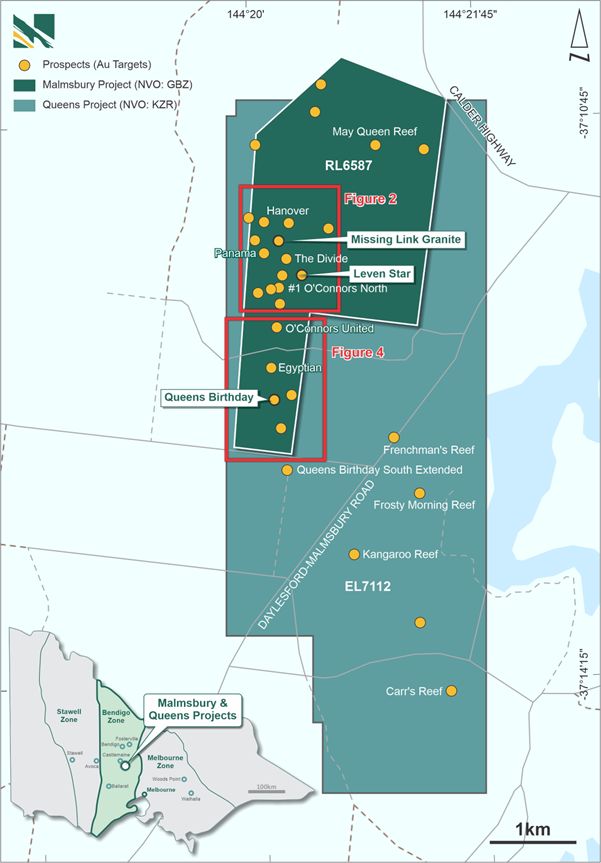

The Company has recently completed an 11-hole, 3,162 m diamond drill program at the Malmsbury Project, with positive results generated from several holes reported previously (see Novo press release), and now including high-grade assays from the Queens Birthday and Leven Star reefs. Key results generated from drilling include:
- 3.1 m @ 9.27 g/t Au from 400.9 m (MD20)
- 8.1 m @ 5.79 g/t Au from 131.9 m (MD21);
- 6.2 m @ 3.92 g/t Au from 144.6 m (MD21); and
- Step-out hole (MD22) intersected 45 m @ 0.23 g/t Au from 134 m, 80 m north of previous reported drilling (MD17)
Novo exercised its option over the Malmsbury Project to earn a 50% interest, and the right to earn an additional 10% interest by incurring A$5 million in exploration expenditure over a four-year period2.
Novo exercised its option over the Queens Project to earn a 50% interest, and the right to earn an additional 20% interest by incurring A$5 million in exploration expenditure over a five-year period3.
Results referred to in this news release are not necessarily representative of mineralization throughout the Malmsbury Project and the Queens Project.
DETAILS
Drilling Program Update
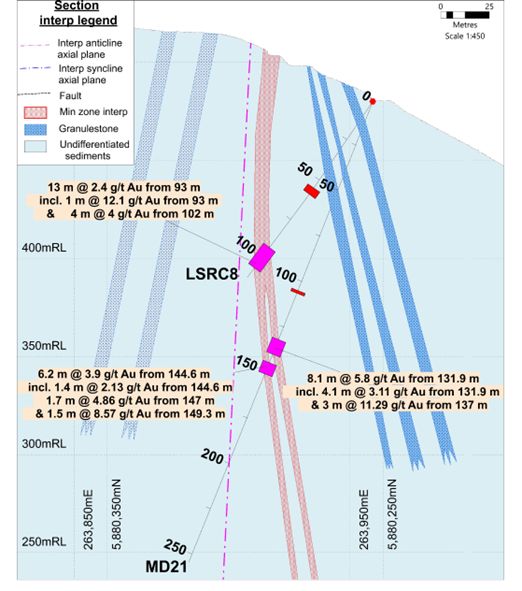
All gold and multi-element assays have now been returned from the 11-hole, 3,162 m diamond drilling program at the Malmsbury Project. Significant results from the final three holes (MD20, MD21 and MD22) are presented herein. Significant results for earlier holes (MD13 through MD19) have been reported previously.4,1,5
Table 1 below highlights new >1 gram metre results reported for drill holes MD20, MD21 and MD22 testing reef-related mineralization. Intersections presented for MD20 are considered at or near true width. An oblique component to the intersections in both MD21 and MD22 is interpreted. True width intersections will reduce for MD21 and MD22 when mineralization is interpreted and modelled.
Table 1: Significant intercept table for results from drill holes MD20 and MD21 and MD22. The table is generated using a 0.3 g/t Au cut-off grade and no more than 2 m internal waste. Higher grade “Includes,” intercepts calculated with 1 g/t Au cut-off grade and no internal dilution. All intervals > 1 gram metre Au reported here.
| HOLE ID | COORDSYS | Collar Details | AZI
GRID |
DIP |
Includes |
DEPTH
FROM |
DEPTH
TO |
Au
(ppm) |
Width
(m) |
Gram*
metre |
||
| EASTING | NORTHING | RL | ||||||||||
| MD20 | MGA94_55 | 263828 | 5878871 | 477 | 260 | -58 | 244.8 | 245.8 | 1.13 | 1 | 1.13 | |
| MD20 | MGA94_55 | 263828 | 5878871 | 477 | 260 | -58 | 400.9*1 | 404 | 9.27 | 3.1*1 | 28.74*1 | |
| MD20 | MGA94_55 | 263828 | 5878871 | 477 | 260 | -58 | Inc. | 400.9*1 | 403.24 | 12.0 | 2.34 | 28.11*1 |
| MD21 | MGA94_55 | 263959 | 5880254 | 481 | 318.6 | -68.4 | 105 | 106.5 | 2.53 | 1.5 | 3.79 | |
| MD21 | MGA94_55 | 263959 | 5880254 | 481 | 318.6 | -68.4 | 131.9 | 140 | 5.79 | 8.1 | 46.90 | |
| MD21 | MGA94_55 | 263959 | 5880254 | 481 | 318.6 | -68.4 | Inc. | 131.9 | 136 | 3.11 | 4.1 | 12.74 |
| MD21 | MGA94_55 | 263959 | 5880254 | 481 | 318.6 | -68.4 | Inc. | 137 | 140 | 11.29 | 3 | 33.86 |
| MD21 | MGA94_55 | 263959 | 5880254 | 481 | 318.6 | -68.4 | 144.6 | 150.8 | 3.92 | 6.2 | 24.33 | |
| MD21 | MGA94_55 | 263959 | 5880254 | 481 | 318.6 | -68.4 | Inc. | 144.6 | 146 | 2.13 | 1.4 | 2.98 |
| MD21 | MGA94_55 | 263959 | 5880254 | 481 | 318.6 | -68.4 | Inc. | 147 | 148.7 | 4.86 | 1.7 | 8.25 |
| MD21 | MGA94_55 | 263959 | 5880254 | 481 | 318.6 | -68.4 | Inc | 149.3 | 150.8 | 8.57 | 1.5 | 12.86 |
| MD22 | MGA94_55 | 263587 | 5880638 | 471 | 93.9 | -45.9 | 7 | 9 | 0.59 | 2 | 1.17 | |
| MD22 | MGA94_55 | 263587 | 5880638 | 471 | 93.9 | -45.9 | 87.6 | 88.8 | 3.81 | 1.2 | 4.57 | |
| MD22 | MGA94_55 | 263587 | 5880638 | 471 | 93.9 | -45.9 | 122.4 | 126.5 | 1.38 | 4.1 | 5.65 | |
*1 Intersection in MD20 remains open. No sampling immediately prior to mineralised interval from 400.9 m.
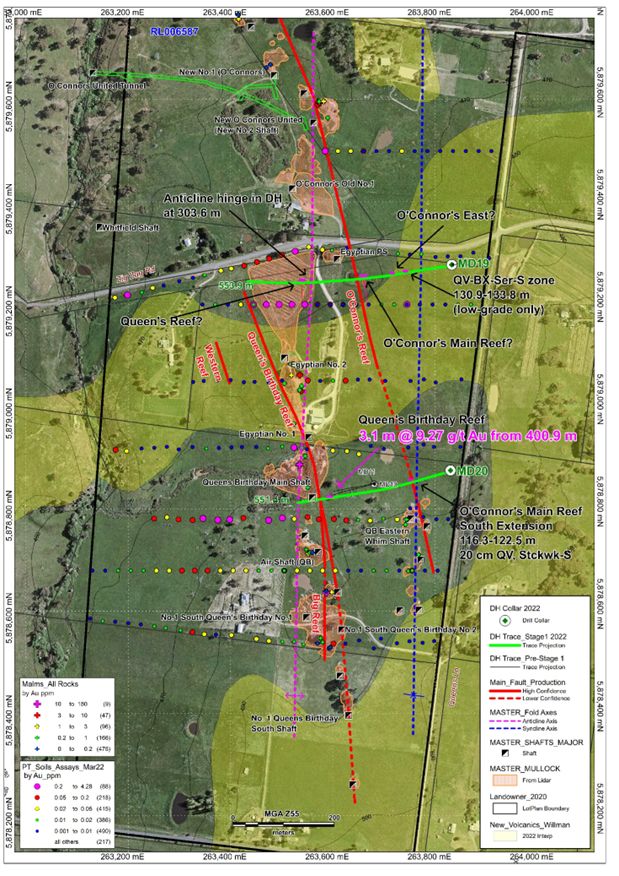
Table 2 below highlights new >1 gram metre results reported for a significant intersection in MD22 across the mineralised felsic intrusive (Missing Link Monzogranite) representing intrusion related gold (“IRG”) mineralization and/or intrusion-hosted mineralization. An oblique component to the intersection presented for MD22 is interpreted. Different parameters to calculate the intersections are used for reef-related verses IRG or intrusion hosted mineralization. These parameters are outlined clearly in the respective tables.
Table 2: Significant intercept table for result across mineralised felsic intrusive (Missing Link Monzogranite) in drill holes MD22. The table is generated using a 0.1 g/t Au cut-off grade and no more than 5 m internal waste. All intervals > 1 gram metre Au reported here.
| HOLE ID | COORDSYS | Collar Details | AZI
GRID |
DIP |
Includes |
DEPTH
FROM |
DEPTH
TO |
Au
(ppm) |
Width
(m) |
Gram*
metre |
||
| EASTING | NORTHING | RL | ||||||||||
| MD22 | MGA94_55 | 263587 | 5880638 | 471 | 93.9 | -45.9 | 134 | 179 | 0.23 | 45 | 10.41 | |
The above references an opinion and is for information purposes only. It is not intended to be investment advice. Seek a licensed professional for investment advice. The author is not an insider or shareholder of any of the companies mentioned above.
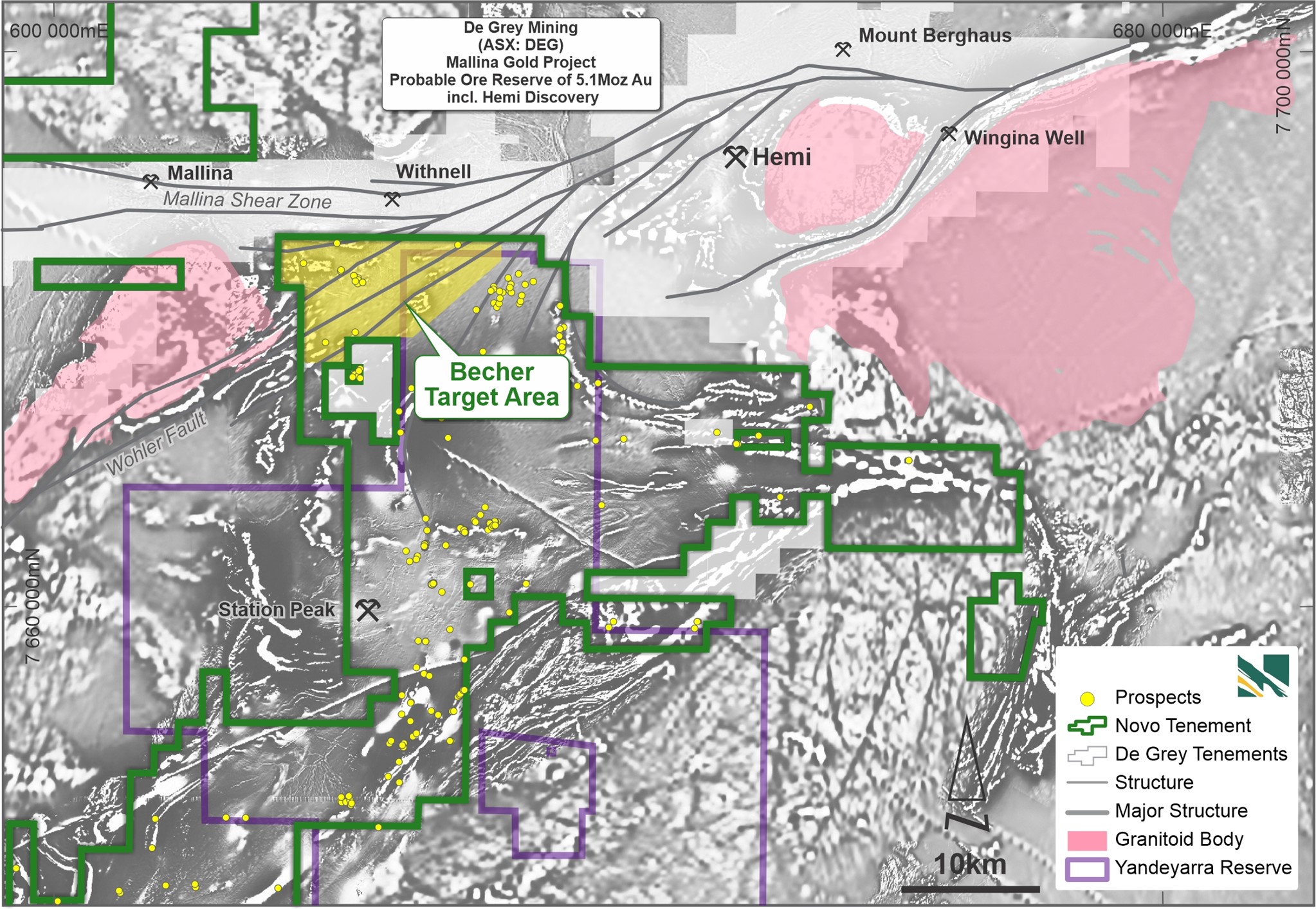

Novo Resources (TSX:NVO) has reported an exploration update from the ongoing drilling program in the Becher Area of the Egina District in Australia. The program includes systematic regional aircore drilling including more than 650 holes for 16,500 m of > 30,000 m program completed so far with a deeper RC drilling program intended to follow-up significant aircore results and test discrete targets.
The programs are in progress and testing high-priority structural and intrusive-related gold targets. The initiative was begun after two heritage surveys were recently completed at the Becher area. The aircore drilling at Becher complements the surface soil anomaly at Nunyerry Norther, about 80 kilometres south of Becher within the same district. The drill program will continue through the end of 2022 and into 2023.
Dr. Quinton Hennigh, Non-Executive Co-Chairman of Novo Resources commented in a press release: “Our first aircore drill results have yielded strong gold results at the Becher Area, indicating that the Whillans and Irvine shear zones are indeed prospective for deposits similar to those at De Grey’s adjacent Mallina project. Aircore drilling, a means of rapid, shallow drilling widely used across Australia as a first pass means of testing new areas for mineralization, is proving highly effective at Becher. Several large-scale anomalies are emerging, the largest of which is 650m across and situated along the southern Irvine shear zone. Alteration assemblages, lithologies, geochemical associations and size of these mineralized areas are similar to those observed in other nearby large gold discoveries. Although we have lots more drilling to complete and results to come in, the anomalies suggest that deeper drill testing is required.”
Highlights from the results are as follows:
- Standout gold results have been intersected on the southern Irvine Shear corridor including 20 m @ 0.67 g/t Au, as part of the current aircore drilling program at the high priority Becher Area in the Egina District.
- Over 650 shallow aircore holes for 16,500 m of the > 30,000 m program have been completed.
- The aircore program will test multiple structural and intrusive targets along a series of significant mineralized corridors, some interpreted to extend to De Grey Mining Limited’s (“De Grey”) Hemi gold deposit within the Mallina gold project (“Hemi”).
- Several additional quartz veined, large-scale sericite-silica-sulphide alteration zones have been identified from drilling across the Irvine and Whillans Shear corridors, with assays pending.
- Deeper reverse circulation (“RC”) drilling will commence in November 2022, designed to follow-up significant aircore results and test discrete drill targets within the Becher Area.
- Numerous targets have been enhanced or newly identified from a recent high resolution aeromagnetic and radiometric survey, coupled with detailed ground gravity surveys which have advanced structural interpretation and geological understanding.
- Two heritage surveys were recently completed, enabling infill and extensional aircore drilling traverses and RC drilling to be completed for the remainder of 2022 and first half of 2023.
- Initial results from the Becher Area, combined with previously reported results from Nunyerry North1, reconfirm potential for the Egina District to be a standalone gold production hub.
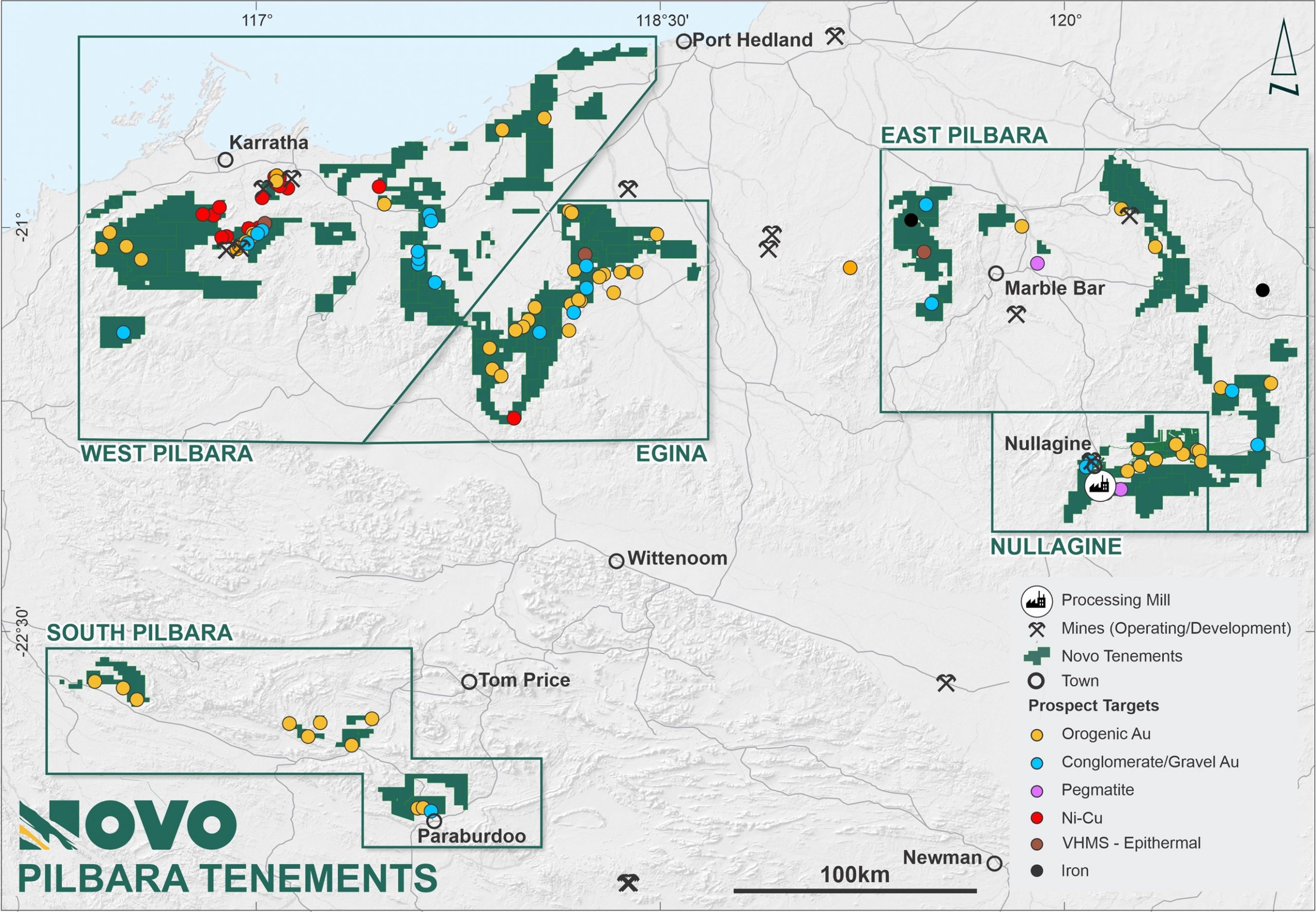

EGINA DISTRICT
Becher Area
The Becher Area (northern E47/3673, 100%-owned by Novo) contains multiple priority orogenic gold targets in the highly prospective and under-explored Mallina Basin. The area is located ~28 km to the WSW of De Grey’s Hemi gold deposit2. Novo’s interpretation of a series of significant shear corridors, including the ENE trending Irvine and Bonatti Shears (part of the regional Wohler Fault using GSWA 1:100,000 scale mapping nomenclature) and the EW trending Whillans and Heckmair Shears, is key to delineating these newly defined targets.
The current > 30,000 m aircore drilling program commenced in early September 2022, with over 650 holes for 16,500 m completed to date. 16 regional traverses at approx. 640 m line spacing and 25 m hole spacings have been completed along the Irvine Shear and Whillans Shear, with the opportunity to infill to 320 m spaced lines now possible given the recently completed second heritage survey on E47/3673. Drilling was designed as part of a large-scale systematic targeting program, supported by recent high resolution geophysical data sets, in conjunction with field mapping and sampling and research of all relevant historical data1.
Aircore drilling is best suited to areas with abundant cover or oxidation, easily drilling through unconsolidated or saprolitic material testing for gold and pathfinder element (arsenic, antimony, bismuth, tellurium, etc.) anomalism to identify broader zones of geochemical dispersion.
A minimum of 30,000 m of aircore drilling has been planned for 2022, however Novo expects this to be exceeded. The program will test four shear corridors and numerous sanukitoid targets, as well as antimony-arsenic-gold soil anomalies defined by previous explorers.
Results have been received from the first assay batch of 4 m composite samples analysed by PhotonAssay for the southernmost drill lines on the Irvine Shear Corridor (Figure 5). Four zones for infill aircore drilling have been identified from geological logging and current assay return. 1 m split samples and multielement assays are pending for anomalous drill holes.
Best intercepts include:
- 6 m @ 0.15 g/t Au from 24m (A0028)
- 12 m @ 0.16 g/t Au from 12m (A0029)
- 8 m @ 0.22 g/t Au from 4m (A0033)
- 20 m @ 0.67 g/t Au from 0m (A0034); examples of the chips from this zone are shown in Figure 5
- 12 m @ 0.24 g/t Au from 0m (A0035)
- 6 m @ 0.21 g/t Au from 24m (A0038)
Refer to Appendix 1 below for a complete list of assay results. True widths cannot be estimated at this time.
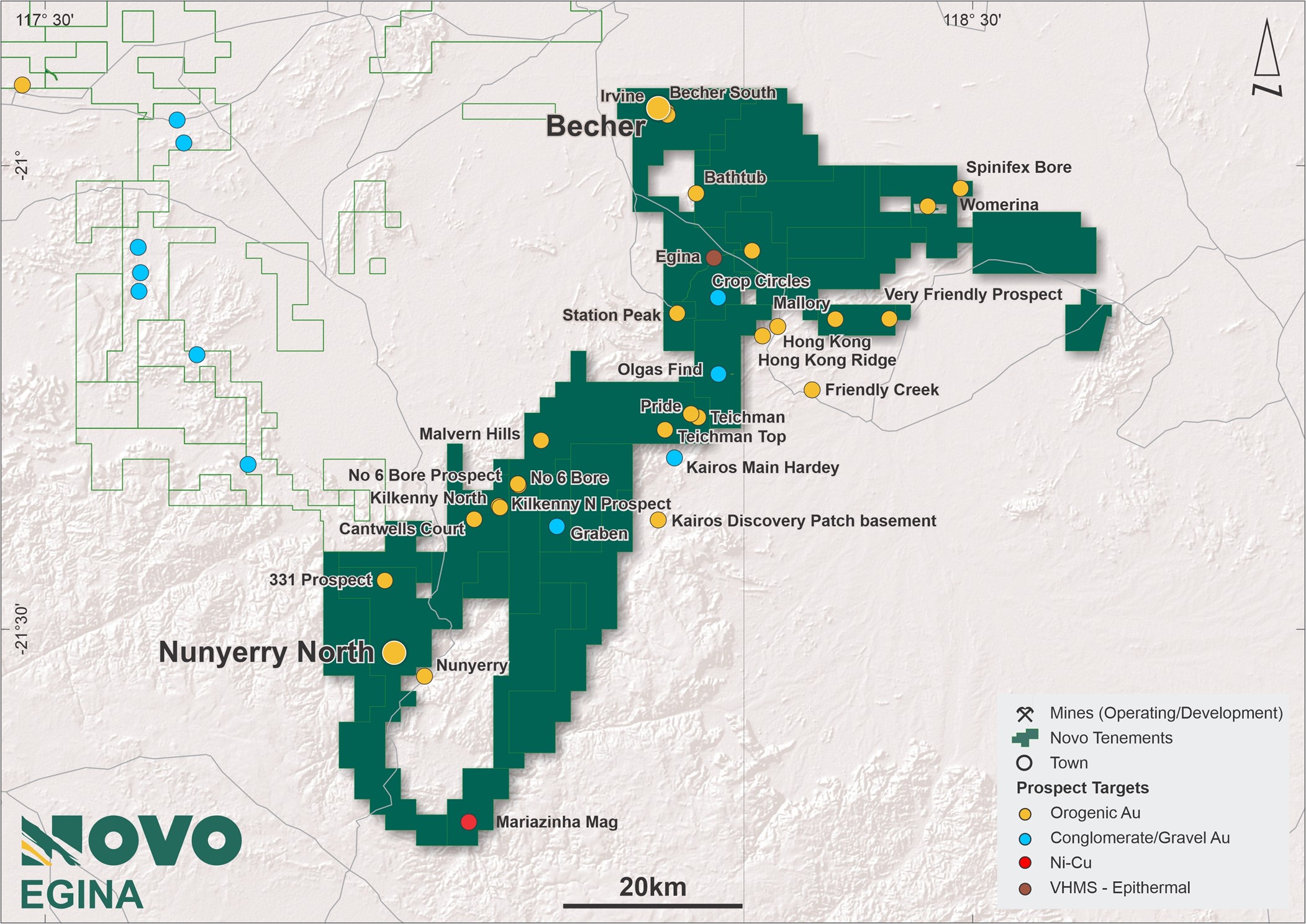

Nunyerry North
The geology of the Nunyerry North target area includes quartz vein-related gold mineralization within a sequence of ultramafic komatiites and mafic rocks, juxtaposed by regional shears and offset faults. Novo’s exploration licence 47/2973 is 70%-owned, with the remaining 30% held by Mark Creasy and entities controlled by him.
A significant high-order gold soil anomaly at Nunyerry North now extends over 1.4 km of strike, with a second 1.2 km long soil anomaly at > 30 ppb gold defined south of the main target. Rock chip sampling returned peak high-grade results from quartz veins including 8.81 g/t Au, 7.39 g/t Au and 1.23 g/t Au1. Further detailed mapping has defined additional swarms of quartz veins and specimen gold has been detected in the main target area1.
Follow-up work planned includes heritage surveys and logistics for road access in preparation for drilling in 2023.
Source: Novo Resources
The above references an opinion and is for information purposes only. It is not intended to be investment advice. Seek a licensed professional for investment advice. The author is not an insider or shareholder of any of the companies mentioned above.
Novo Resources (TSX:NVO) has reported assay results from the diamond drilling program on RL006587 at the Malmsbury Project in Victoria, Australia.
Novo exercised its option over the Malmsbury Project to acquire a 50 percent stake and the right to earn an extra 10 percent interest by investing A$5 million in exploration costs over the following four-year period. The company’s results follow up on early success from the first 3 drill holes of the program, and confirm high potential for mineralization extension.
Ms. Kas De Luca, General Manager of Exploration at Novo Resources, commented in a press release: “These preliminary, high-grade results from the Malmsbury Project are very promising. Following the early success and results from the first 3 holes of this drill program, further work to confirm potential for mineralization extension, including IP and additional drilling, are planned for 2022 and early 2023. We look forward to working with our partner, GBM, to continue advancing the exciting potential of the Malmsbury Project.”


Highlights from the results are as follows:
- Drilling on the 50%-owned Malmsbury gold project (“Malmsbury Project”) joint venture with ASX-listed GBM Resources Ltd. (“GBM”), located 50 km SSW of the high-grade Fosterville gold mine in Victoria, Australia, has intersected a significant high-grade gold mineralized zone.
- Significant results received to date include 14 m @ 6.1 g/t Au from 120 m, 10 m @ 4.9 g/t Au from 173 m and 4 m @ 8.6 g/t Au from 188 m (MD16); 7.8 m @ 3.6 g/t Au from 32.2 m (MD13); and 9.1 m @ 2.4 g/t Au from 65.4 m (MD14). These results are not necessarily representative of mineralization throughout the Malmsbury Project. Remaining assays for the program are expected over the coming months.
- 2,000 m of diamond drilling completed (>75% of program) with full gold and multi-element assays received from the first three of six holes completed and sampled to date. Assays confirm high-grade shoot potential and splay features on the Leven Star mineralization and extension potential for the Missing Link Reef.
- Intersection of altered, quartz veined, and sulphide bearing Missing Link Monzogranite confirmed in drill hole MD17, from 204 m to 269 m. Drilling confirms a steep (70 – 80°) east-dipping elongate body that widens at depth and validates the potential for an intrusion hosted and/or intrusion related gold (“IRG”) system at the Malmsbury Project. Full gold and multi-element assays for MD17 are still pending at this time.
- Missing Link Monzogranite target now defined over 340 m strike and 40 m width (at surface) and remains completely open at depth.
- Current diamond drilling phase nearing completion (Q3 2022), with recent success to drive a larger second phase of diamond drilling later in 2022 or early 2023.
- 2D/3D induced polarization (“IP”) survey planned to help define sulphide rich granite-related targets and disseminated sulphide haloes around gold reef targets.


DETAILS of Drilling Program 2021 – 2022
Approximately 2,000 m (7 holes, 1 in progress) of a circa 2,650 m planned diamond drilling program have been completed to date at the Malmsbury Project. At the time of writing, gold, and multi-element assays from three of six holes completed have been returned in full. Significant results from these early holes are highly encouraging and include, but are not limited to:
- 14 m @ 6.1 g/t Au from 120 m; including 3 m @ 11.1 g/t Au from 131 m (MD16)
- 10 m @ 4.9 g/t Au from 173 m; including 7 m @ 6.8 g/t Au from 175 m (MD16)
- 4 m @ 8.6 g/t Au from 188 m (MD16)
- 7.8 m @ 3.6 g/t Au from 32.2 m; including 1.85 m @ 12.5 g/t Au from 34.15 m (MD13)
- 4 m @ 2.9 g/t Au from 80 m; including 0.4 m @ 24.4 g/t Au from 81.2 m (MD13)
- 9.1 m* @ 2.4 g/t Au from 65.4 m; including 2.5 m* @ 5.9 g/t Au from 70.4 m (MD14)
*Interval not closed owing to 0.5 m core loss from 72.9 m – 73.4 m
Table 1 below provides a list of significant intersections (reporting >1 gram metre) using parameters that include a 0.3 g/t Au cut-off and no more than 2 m internal waste for drill holes MD13, MD14 and MD16. Reported intersections for MD14 and MD13 are considered at (or close to) true widths, with exception to the Leven Star Reef intersection in MD13 ca. 32 m – 40 m that will have an oblique component. Reported intersections for MD16 are considered to have an oblique, down-dip component, and thus true widths will have reduced intersections.
Table 1: Significant intercept table for results from drill holes MD13, MD14 and MD16. The table is generated using a 0.3 g/t Au cut-off grade and no more than 2 m internal waste. Higher grade “Includes,” intercepts calculated with 1 g/t Au cut-off grade and no internal dilution. All intervals > 1 gram metre Au reported here.
Drill holes MD13, MD14 and MD16 were drilled to target high-grade potential shoot zones and other high-order gold targets, including the Missing Link Gold Reef. In addition, these holes will provide material for metallurgical test-work from the Leven Star mineralization. All three holes were drilled as larger core diameter HQ3 (triple tube method) to provide a bigger sample size and maximise core return. All holes successfully intersected the Leven Star Reef mineralization.
Drill hole MD14 was planned to drill beyond the interpreted Leven Star Reef position to test extensions to the Missing Link and Panama South historic gold reef workings (Figure 2 and 3). Significant gold mineralization within multiple puggy, sulphide rich, sericite altered shears in distinctly bleached sediments from 65 m – 74 m (Refer to Table 1 for significant intercepts), strongly suggest that the Missing Link Reef has been intercepted in this hole, and add a significant strike and down-dip extension to the known extent of this gold reef target.
The Missing Link Reef was also likely intersected in MD13 within similarly bleached and sericite altered sediments from 71 m – 84 m, returning 4 m @ 2.9 g/t Au from 80 m, including a narrow high-grade interval of 0.4 m @ 24.4 g/t Au from 81.2 m, and confirming the high-grade potential for this reef (Refer to Table 1 for additional significant intercepts).
Drill hole MD16 targeted a complex potential splay and high-grade shoot zone on the Leven Star mineralization where previous historic reverse circulation (“RC”) drilling conducted by GBM intersected 7 m @ 5.4 g/t Au (LSCR015) including 2 m @ 16 g/t Au from 67 m2 (the “GBM Results”) (not verified by Novo), on-section and up-dip from MD16. Three distinct zones of high-grade gold mineralization were returned from MD16, including:
- An upper zone characterized by wide limonitic tectonic fault breccia in strongly oxidized material from 73 m – 96 m (refer to Table 1 for significant intercepts);
- A middle, fresh sulphide zone within a sulphide-rich (arsenopyrite stringers and disseminations) and moderately silicified, sericite altered and distinctly bleached siltstone and fine sandstone package from 120 m – 141 m (refer to Table 1 for significant intercepts); and
- A lower fresh sulphide zone (potential newly discovered splay) from 173 m – 197 m (refer to Table 1 for significant intercepts).
Reported intercepts for MD16 are interpreted to be oblique. Exact true widths cannot be determined until mineralization trends are remodelled to incorporate the recent results (including the new potential splay zone); however, these are anticipated to be a reduction in the stated intersection widths.
Drill hole MD17 was designed as a westerly directed, ca. 400 m hole to test the recently discovered Missing Link Monzogranite at depth, in addition to the Missing Link and Hanover West historic gold reefs. This hole aimed to determine the geometry and gold endowment of the intrusion and targeted the monzogranite for its potential as an IRGS, in addition for the potential for orogenic vein style mineralization.
MD17 successfully intercepted the Missing Link Monzogranite between 204 m – 269 m down hole, in addition to a smaller and potentially parallel shallow sub-surface granite dyke interpreted in strongly oxidised material near the collar. Drilling confirms a steep (70 – 80°) east-dipping geometry for the intrusive that widens noticeably at depth. The intrusive is characterized by strong sericite alteration and disseminated sulphides throughout with regular intervals of planar white quartz-sulphide stockwork veining. A distinct 1 m-wide sulphide-shear-breccia within strongly quartz veined sandstone occurs within a metre of the upper granite contact.
Source: Novo Resources
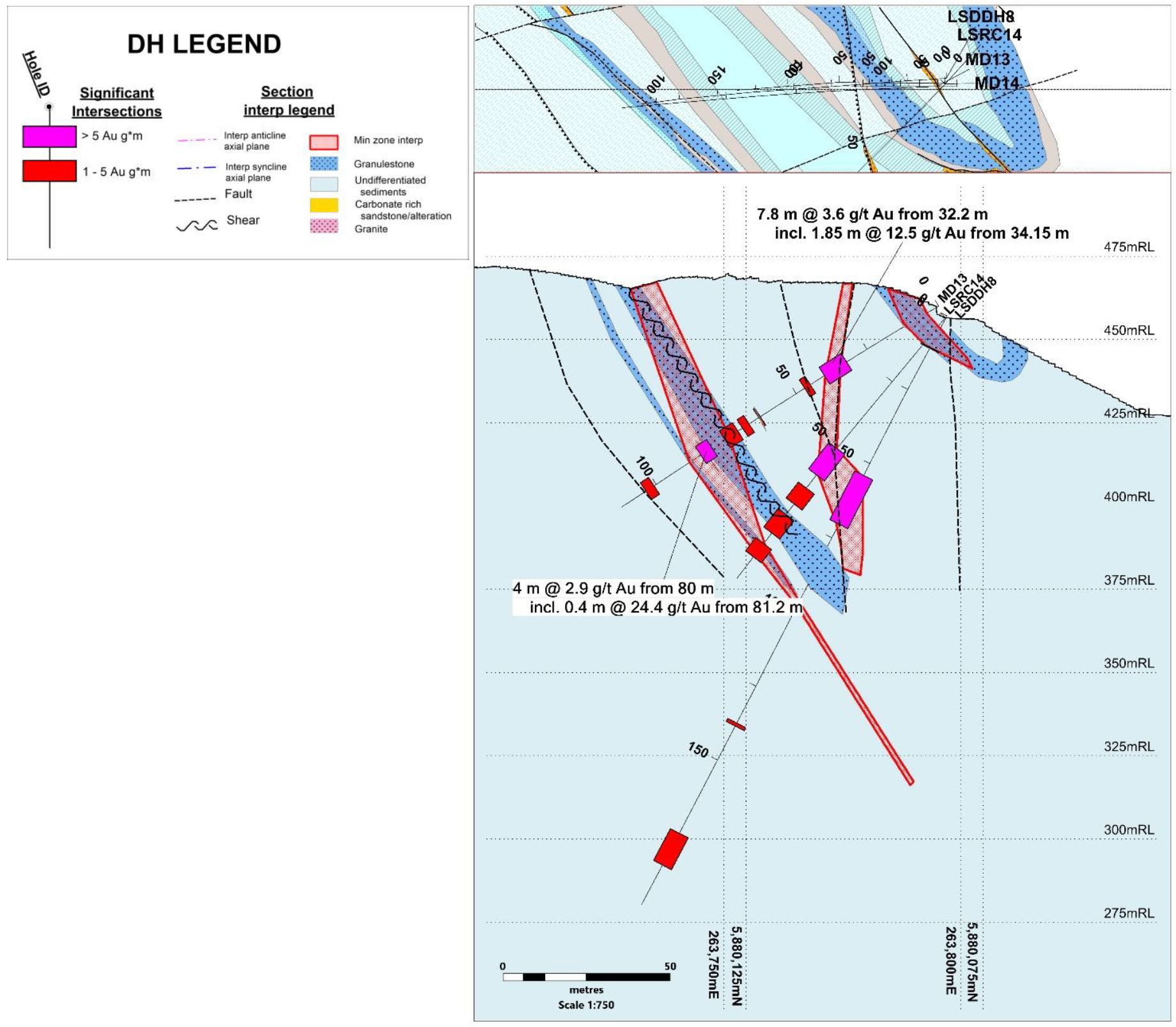







The above references an opinion and is for information purposes only. It is not intended to be investment advice. Seek a licensed professional for investment advice. The author is not an insider or shareholder of any of the companies mentioned above.
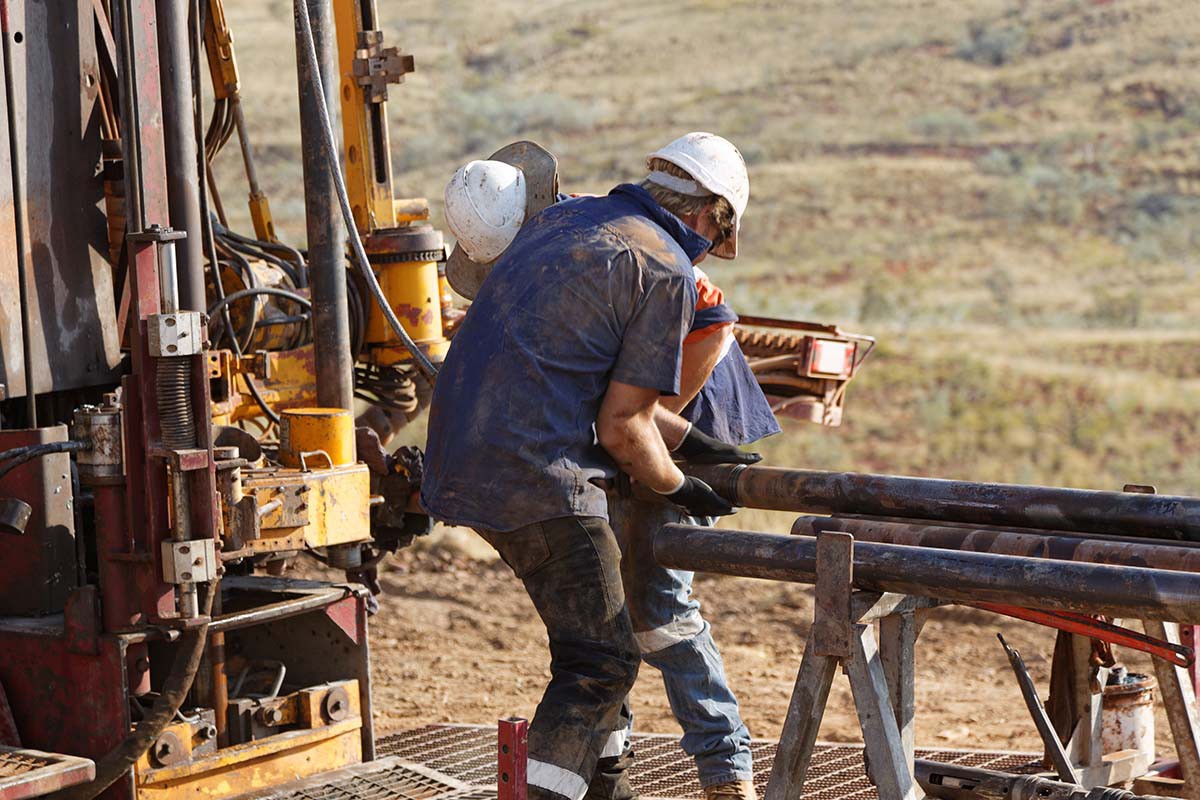

Novo Resources (TSX:NVO) announced last Friday that it will begin its brownfield exploration programs at its highly prospective Nullagine gold project located in the East Pilbara District of Western Australia.
The new exploration programs will focus on oxide opportunities at the Nullagine gold project with a 15,000 m reverse circulation drilling program which started at the Parnell-Vulture trend, also known as Parnell, during the first week of November 2021. This will take the company into the first quarter of 2022 as well.
Gold assay results from the new drill program are expected to be released by December 2021. Novo Resources has a priority arrangement with Intertek1 to provide PhotonAssay gold results.
Parnell-Vulture
Parnell is located about 45 kms from the Golden Eagle processing facility and can be accessed by an existing reliable haul road with surrounding infrastructure attached. Parnell covers a strike length of approximately 2 kms and contains a series of vein-hosted targets with historical drill intercepts.
The Parnell and Vulture reverse circulation programs are the first programs at the Nullagine gold project as things begin to ramp up, with forward programs currently being generated at several priority basement targets.
Novo has already conducted detailed mapping and gridded soil sampling at Parnell and Vulture to determine the mineralization potential, but has yet to acquire the necessary details to validate historical data. Once this information is acquired, it will serve as further confirmation and guidance for targets. However, significant rock samples from both Parnell and Vulture highlight the presence of high-grade gold targets, and further confirm the prospectivity of this area.
Multiple Projects on the Go
Novo’s primary focus is exploring and developing gold projects in the Pilbara region of Western Australia. It has several ownership interests across its 13,000 sq km land package, and has several different projects on the go.
Novo Resources’ main focus is its Egina gold project, where it is currently exploring and testing innovative exploration techniques under a JV with Japan’s Sumitomo Corporation. The company also has a 100% interest in the Purdy’s Reward gold project and a 100% interest in the production-ready Beatons Creek gold project.
The new drilling programs follow other recent news from Novo Resources (TSX:NVO) as its Golden Eagle processing facility or “Golden Eagle Mill” had restarted production at the beginning of November. The faculty underwent opportunistic maintenance as the company repaired its main crushing unit, which is now back online.
The above references an opinion and is for information purposes only. It is not intended to be investment advice. Seek a licensed professional for investment advice. The author is not an insider or shareholder of any of the companies mentioned above.
If you would like to receive our free newsletter via email, simply enter your email address below & click subscribe.
CONNECT WITH US
Tweets
Tweet with hash tag #miningfeeds or @miningfeeds and your tweets will be displayed across this site.
MOST ACTIVE MINING STOCKS
Daily Gainers
        |
RTG.TO | +60.00% |
    |
ERL.AX | +50.00% |
    |
MRQ.AX | +50.00% |
        |
AFR.V | +33.33% |
    |
CRB.AX | +33.33% |
        |
GCX.V | +33.33% |
        |
RUG.V | +33.33% |
        |
CASA.V | +30.00% |
        |
BSK.V | +25.00% |
        |
PGC.V | +25.00% |
Articles
FOUND POSTS
Arras Minerals (TSXV:ARK) Updates on Elemes Drill Program in Kazakhstan
December 19, 2024
Potential Trump Tariffs Could Reshape Copper Market Dynamics in 2025
December 17, 2024












